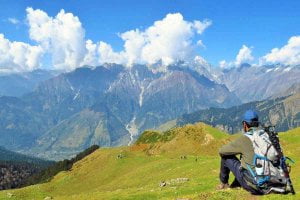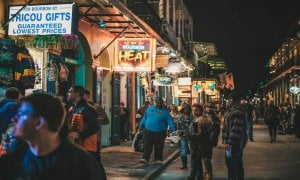Hospitality means making the tourists feel happy and fully contented. Welcoming tourists not only as your guests but also the guests of the hotels is the essence of hospitality. Hospitality Industry makes planned efforts to establish and maintain mutual understanding between an organization and the public i.e., the business of keeping and making of friends and environment also.
Origin and Evolution of Hospitality Industry
The hospitality industry is a part of a larger enterprise known as travel and tourism industry. The travel and tourism industry is a vast group of business with one goal in common: providing necessary or desired services to travellers. Ever since man started to travel in search of food, work, better prospects or leisure, there has been a demand for overnight stay. Lodging houses were built to provide accommodation along the trade and caravan route. Missionaries and religious travellers were accommodated by local people in their houses. From modest origins, hospitality and tourism rose to become two of the largest worldwide industries. Warriors or traders were the early travellers but they did not have hotels to accommodate them. The warriors used tents but the merchants sought to trade tools, clothing and livestock and traded merchandise for lodging. The inns offered little more than a cot or a bench in the corner of a room or a stable. Most of them were private residences that offered temporary residence or lodging to strangers. Guests stayed in large communal rooms where sanitation and privacy were non-existent. After the establishment of money in 6th century BC, Inn keeping was one of the first commercial enterprises and hospitality was one of the first services for which money was exchanged.
But the demand for shelter kept on increasing with the development of highways and technological advancements in modes of travelling. As a result, inns gave way to hotels. Hospitality is a massive industry providing home facilities away from home to millions of tourists. These tourists can be segmented into business and leisure tourists. All have different needs and expectations. However, the hospitality industry is so versatile that it is catering to the needs of all of them. Advances in transportation enabled more people to travel greater distances at less cost spreading tourism across the globe.
In medieval, Europe monasteries rationally offered hospitality to the travellers. The main aim in offering hospitality was for pilgrims as monasteries were found at the site of holy place in early stage. In early Europe inns, they were especially designed as profit making business and it was the first commercial venture in hotel keeping. Hotel keeping has also influenced mode of transport, with advent of railways came station hotels, and with aircraft came airport hotels, with motorways and extensive road travel like motels, boatels and ship bought floating hotels into existence. Inn keeping is believed to be started in 1200 AD. In 1650 AD, Mr. Pascal opened cafe in Paris and coffee house in London. During industrial revolution during 1750-1820, the English Inns were considered finest in the world. Hotel de Henry was one of the 1st European hotels built in 1788 with capacity of 60 rooms. Growth of hotel inns continues with the concept of family hotels i.e. run by the families called Mom & Pop in England.
The industrial revolution, which started in the 1760s, facilitated the construction of hotels everywhere, in mainland Europe, in England and in America. In colonial America, inns were modeled after European inns. Beds and rooms had to be shared with strangers. Throughout 1800s, American innkeepers improved their services and continued to build larger properties. Most of these were located in seaport town since sea transport was very widely used mode or travel and transport then. The Termand house was 1st class hotel made in Boston in 1829 and it provided private guest room, door with lock and free soap bellboy service. It is called Adam and Eve of modern hotel industry.
Hotels were established in city centers in New York first and in Copenhagen. At the beginning of the 1800s, the Royal Hotel was built in London. Holiday resorts began to flourish along the French and Italian Rivieras. In Japan, Ryokan guest houses sprang up. In India, the government-run Dak bungalows provided reliable accommodation for travellers. The first American hotel ‘the City Hotel’ opened in 1794 in the New York City. It was one of the largest buildings in the city and was built exclusively for hotel purpose. It had 73 guest rooms. ‘Adelphi Hotel’ in New York was the first high-rise structure in the city. In 1822, in Venice, a certain Giuseppe Dal Niel transformed an old palace into a hotel and gave it his name ‘Le Danieli’. As trains began to replace horsedrawn transport, highway inns for stage coaches started to decline. During this period, the Shepheard Hotel in Cairo was founded, the result of a complete transformation of an ancient city-centre harem.
L’ Hotel des Bergues was built in the spring of 1834 AD on the shore of the Lake of Geneva. One of its founders, Guillaume Henri Dufour became a famous Swiss general. In 1840, l’ Hotel des Trois Couronnes was established in Vevey in Switzerland and the Baur au Lac in Zurich, fully refurbished since 1995. In New York, the New York Hotel was the first to be equipped with private bathrooms. The ‘Bayerischer Hof’ was built in Munich in 1841 AD, followed in 1852 AD by the ‘Vier Jahreszeiten’. These two famous establishments were completely renovated after the Second World War.
The inauguration of the Grand Hotel in Paris took place on 5 May 1862 in the presence of the Empress Eugenie. The orchestra, directed by Jacques Offenbach, played the Traviata. This building was designed by the architect Alfred Armand, in order to show the elite of travellers from all over the world the progress made under the Second Empire by science, arts and industry.
In Athens in 1874, Stathis Lampsas, a chef by profession, realised his dream by building l Hotel Grande Bretagne. Athens was suffering at that time from a shortage of water. It is said that the personnel bought water from carriers in the street to bring to the 80 bedrooms and the two bathrooms. Of course, the establishment has undergone several renovations since that time. The first school for hoteliers was founded in Lausanne, Switzerland in 1890 by J. Tschumi, Director of the Beau Rivage in Lausanne, and A.R. Armleder, the ‘father’ of the Richemond in Geneve. In Monte Carlo, l’ Hotel Hermitage opened its doors in 1896, offering its guests the refined and luxurious atmosphere enjoyed by the rich at the close of the nineteenth century. Shortly afterwards, the Victoria Hotel in Kansas City offered bathrooms with every room. The Netherland Hotel in New York City then became the first to provide all its guests with their own telephone.
The early years of the twentieth century were rich in new hotels which rapidly became prestigious. Edouard Niiermans, the ‘architect of palaces’, transformed the Villa ‘Eugenie’, the summer residence of the Emperor Napoleon III and his wife Eugenie de Montijo, in 1900. Mr. Ellsworth M Statler started new chain and made his first hotel ‘Buffalo Statler’ on 18 Jan 1908. He gave a slogan ‘room and a bath for a dollar and a half’. In 1905, he built ‘Hotel du Palais’ in Biarritz. In 1913 his ‘Negresco’ was opened in Nice, in the presence of seven kings.
In 1950, new concepts such as motels, boatels, floatels, rotesl and loatels were developed after the Second World War and many trained staff joined the army hence standard of service lowered, however occupancy was improved. In 1952, Kemmons Wilson formed Holiday Inn and first Holiday Inn was made in 1952 at MemphisTennesse.
In 1960, many individual owners merged themselves with large chain such as Sheraton, Hilton, Hyatt and Holiday Inn for franchising by paying a fee and using the name, reservation system, national and international advertisement and operational manuals.
In 1970, the hotel industry experienced the construction boom. International business rapidly developed and with this a lot of business executives travelled out and modern hotels were developing as per the needs and wants of tourists and business class guests.
The major boom in the hotel industry began in 1980, marked by more inventive marketing and the development of hotels increasingly adapted to a particular type of clientele. This trend brought the demand for the construction of hotels near airports, hotels for conferences, health hotels, ski holiday hotels, holiday villages and marina hotels. The first Property Management Systems (Fidelio, Hogatex, etc.) appeared in the hospitality market. In the eighties, too, the Far East began to prepare itself to welcome both business people and the tourists who were beginning to discover the countries of the rising sun, such as China, South Korea, Thailand and Japan. The international chains (American for the most part) prepared expansion plans for Europe, the Middle and Far East which were mainly aimed at congress participants and business people. The early nineties were characterized by a recession in the hotel business, indubitably caused by reductions in multinationals’ travel budgets and the growing crisis in the Gulf. The Gulf War helped to create great insecurity for both individuals and business. The year 1991 is considered to be the black year of the hotel trade. It forced hoteliers to become more creative in finding ways of attracting guests (special programmes, offers for ‘frequent travelers’, high performance reservation systems) and thus emerge from the crisis with the minimum damage.
Types of Accommodation Units.
The term “tourist accommodation” invariably turns our attention to hotel. But tourist accommodation does not revolve around hotels only. The available types of accommodation can be classified as:
| Pic credit- https://client.hotelbeds.com/accommodation |
1. Hotels
Hotel is a place which supplies board and lodging. It is “a large city house of distinction”; “a place for the entertainment of travellers” and “a public building”. Hotelsprovide accommodation, meals and refreshments for at periods of time for those who stay on the premises and pay for the services provided. Hotels can be classified on the basis of following facilities and services.
• Room charges or price, i.e., budget, luxury, etc.
• Range of facilities, i.e., five stars, no star, etc.
• Location, i.e., resort, motel etc.
• Length of stay, i.e., transit, residential, etc.
• Ownership and management, i.e., chain, individual, etc.
1.1. Types of Hotels.
i) International Hotel or Star Hotel
These hotels are modern western style luxury hotels classified based on an internationally accepted system of classification grading and located in almost all metropolitan and other large cities as well as at principal tourist destinations. Usually, they are located at a prime location in the city. There categories range from 7 to 1 Star grade depending upon the facilities and services provided by these hotels. In addition to accommodation various other facilities are provided to make the stay more comfortable. These facilities include – information counters, banquet halls, conference facilities, a number of shops, travel agency, desk business centre facilities, money changing and safe deposit facilities, theme restaurants, beverages, swimming pool, gymnasium, health clubs and other entertainment programmes in the form of games, music and dance, etc.
ii) Non-Star or Commercial Hotels
These hotels mainly depend upon individual travellers, middle budget tourists and many of the guests are repeat guests. These hotels are located near the business or commercial centres and have easy access to transportation. They provide accommodation, parking space for guests and their visitors, restaurants and sometimes business centre facilities as well. Size of such a hotel varies from small to medium.
iii) Residential Hotels
These hotels are known as apartment house or apartment hotels with the availability of conventional hotel services. These hotels are largely located in big cities and mostly operate under the European Plans.
iv) Floating Hotels
These hotels are located on the surface of the water. It may be on seawater or river water or even on a lake. These hotels provide all the facilities and services of a hotel and are very popular with the tourists. In many cases, across the world old ships have been converted into these types of hotels and have become popular among the tourists.
v) Capsule Hotels
Capsule hotel is the latest innovation in the budget hotel market. The first of its kind was opened in Osaka, Japan in the year 1979. The capsule is a box made of glass reinforced plastic or cement, open either at one side or one end in which they provide some functions of a traditional hotel such as a bed, a clock, radio, colour TV, flexible lighting, a box for valuables and a miniature table for writing.
vi) Transit Transient Hotels.
The locations of this type of hotel are in close proximity of the airports, catering to guests who stay for a limited period of time from few hours to a few days.
vii) Heritage Hotels
Old properties of the royal and aristocratic families are renovated and the old aura is recreated for the tourists to stay in heritage surroundings. The heritage properties are an attraction in themselves and the best example would be the state of Rajasthan and Gujarat in India.
2. Motels
The motel provides parking space to the travelers travelling by automobiles and the rooms opens to the parking lot.
3. Resorts
A resort hotel is one which is visited by holiday makers or tourists for relaxation, recreation and/or for entertainment. Resort hotels cater to tourists and are located near place of some scenic beauty, i.e., the sea, mountains or in ‘off the beaten track destination. The primary reason for visiting a resort is rest and relaxation and these hotels are built with the objective of indoor recreation activities giving visitors special welcome and atmosphere of informality. The services and amenities offered by resorts include swimming pool, tennis court, skiing, boating, surfing and many others. The clientele of resort hotels is mostly persons with considerable income looking for relaxation and recreation.
4. Timeshare Apartments/Condominiums
The concept of timeshare is popular as it gives vacation ownership or holiday ownership and offers the purchaser the right to enjoy, for a set period or interval, each year, vacation time in an apartment or other type of lodging that is a part of a tourist complex, equipped with a variety of services and facilities. The period of time sold is usually based on modules of a week, fortnight or a month.




